feedback on fix to motion-bur in IM 6.4.1-0
Posted: 2008-04-30T16:27:44-07:00
I have retested motion-blur under IM 6.4.1-0 Q16-hdri and it is now properly centered and is of uniform weight. Thank you very much for the fix.
However, I am very puzzled about how to make use of radiusxsigma parameters to achieve a motion blur of 15 pixels. I have used trial and error to achieve a close match to a 15x15 horizontal convolution filter, blur the following image and compare its profile. I am finding that to achieve a 15 pixel horizontal blur equivalent to the convolution, I either need to use 0x1.75+0 or 7x0+0. Neither of these parameters seems to fit the model of radiusxsigma. I would have expected 7.5x0+0 or 0x5+0 to work, but they do not closely match the 15x15 convolution. I was under the impression that if radius=0, then the width would be given by 3xsigma (in this case 3x5=15 and not 3x1.75). On the other hand, if I give it a radius=half of the width with sigma=0, then that should work. In that case radius=7.5 should achieve width=15, but I find that it is closer to radius=7 to get the same effect.
I have looked at the code for MotionBlurImage() and GetOptimalKernelWidth1D(), but am still puzzled, because the latter seems to be used by -blur and -gaussian-blur and the notes there say that width should be 3xsigma for radius=0.
On the other hand, I do see a comment in the header of GetOptimalKernelWidth1D() that the radius does not count the center pixel.
"radius: the radius of the Gaussian, in pixels, not counting the center pixel."
That would then explain why radius=7 gives a good match to a width=15 if the formula is width=2*radius+1. If this is correct, then a comment in the -motion-blur document would probably be appreciated by others and remind me later of this.
I would greatly appreciate it if someone could clarify for me how the motion-blur width is computed from the radiusxsigma and/or check if it is being properly computed, especially when radius=0.
This is not a high priority, but when you can, could you give me some feedback, so that I will know how to compute a motion blur of a given width and angle. In the mean time, I will go under the assumption that the best way to use -motion-blur is to give it a radius=(width-1)/2 and sigma=0.
Starting image:

15x15 convolution
filt15="\
0,0,0,0,0,0,0,0,0,0,0,0,0,0,0,\
0,0,0,0,0,0,0,0,0,0,0,0,0,0,0,\
0,0,0,0,0,0,0,0,0,0,0,0,0,0,0,\
0,0,0,0,0,0,0,0,0,0,0,0,0,0,0,\
0,0,0,0,0,0,0,0,0,0,0,0,0,0,0,\
0,0,0,0,0,0,0,0,0,0,0,0,0,0,0,\
0,0,0,0,0,0,0,0,0,0,0,0,0,0,0,\
1,1,1,1,1,1,1,1,1,1,1,1,1,1,1,\
0,0,0,0,0,0,0,0,0,0,0,0,0,0,0,\
0,0,0,0,0,0,0,0,0,0,0,0,0,0,0,\
0,0,0,0,0,0,0,0,0,0,0,0,0,0,0,\
0,0,0,0,0,0,0,0,0,0,0,0,0,0,0,\
0,0,0,0,0,0,0,0,0,0,0,0,0,0,0,\
0,0,0,0,0,0,0,0,0,0,0,0,0,0,0,\
0,0,0,0,0,0,0,0,0,0,0,0,0,0,0,\
"
convert square31.png -convolve $filt15 square31_IM_filt15.png


Results using radiusxsigma=0x1.75 (but I would have expected 7.5x0)


Results using radiusxsigma=7x0 (but I would have expected 0x5)


Thanks
Fred
However, I am very puzzled about how to make use of radiusxsigma parameters to achieve a motion blur of 15 pixels. I have used trial and error to achieve a close match to a 15x15 horizontal convolution filter, blur the following image and compare its profile. I am finding that to achieve a 15 pixel horizontal blur equivalent to the convolution, I either need to use 0x1.75+0 or 7x0+0. Neither of these parameters seems to fit the model of radiusxsigma. I would have expected 7.5x0+0 or 0x5+0 to work, but they do not closely match the 15x15 convolution. I was under the impression that if radius=0, then the width would be given by 3xsigma (in this case 3x5=15 and not 3x1.75). On the other hand, if I give it a radius=half of the width with sigma=0, then that should work. In that case radius=7.5 should achieve width=15, but I find that it is closer to radius=7 to get the same effect.
I have looked at the code for MotionBlurImage() and GetOptimalKernelWidth1D(), but am still puzzled, because the latter seems to be used by -blur and -gaussian-blur and the notes there say that width should be 3xsigma for radius=0.
On the other hand, I do see a comment in the header of GetOptimalKernelWidth1D() that the radius does not count the center pixel.
"radius: the radius of the Gaussian, in pixels, not counting the center pixel."
That would then explain why radius=7 gives a good match to a width=15 if the formula is width=2*radius+1. If this is correct, then a comment in the -motion-blur document would probably be appreciated by others and remind me later of this.
I would greatly appreciate it if someone could clarify for me how the motion-blur width is computed from the radiusxsigma and/or check if it is being properly computed, especially when radius=0.
This is not a high priority, but when you can, could you give me some feedback, so that I will know how to compute a motion blur of a given width and angle. In the mean time, I will go under the assumption that the best way to use -motion-blur is to give it a radius=(width-1)/2 and sigma=0.
Starting image:

15x15 convolution
filt15="\
0,0,0,0,0,0,0,0,0,0,0,0,0,0,0,\
0,0,0,0,0,0,0,0,0,0,0,0,0,0,0,\
0,0,0,0,0,0,0,0,0,0,0,0,0,0,0,\
0,0,0,0,0,0,0,0,0,0,0,0,0,0,0,\
0,0,0,0,0,0,0,0,0,0,0,0,0,0,0,\
0,0,0,0,0,0,0,0,0,0,0,0,0,0,0,\
0,0,0,0,0,0,0,0,0,0,0,0,0,0,0,\
1,1,1,1,1,1,1,1,1,1,1,1,1,1,1,\
0,0,0,0,0,0,0,0,0,0,0,0,0,0,0,\
0,0,0,0,0,0,0,0,0,0,0,0,0,0,0,\
0,0,0,0,0,0,0,0,0,0,0,0,0,0,0,\
0,0,0,0,0,0,0,0,0,0,0,0,0,0,0,\
0,0,0,0,0,0,0,0,0,0,0,0,0,0,0,\
0,0,0,0,0,0,0,0,0,0,0,0,0,0,0,\
0,0,0,0,0,0,0,0,0,0,0,0,0,0,0,\
"
convert square31.png -convolve $filt15 square31_IM_filt15.png


Results using radiusxsigma=0x1.75 (but I would have expected 7.5x0)


Results using radiusxsigma=7x0 (but I would have expected 0x5)


Thanks
Fred